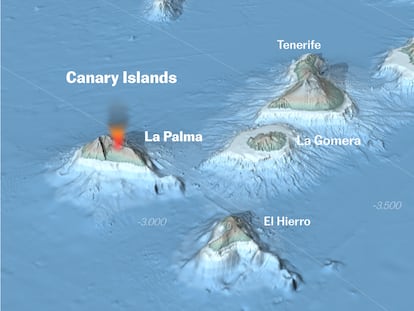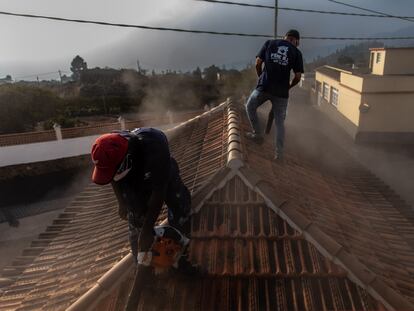Reading the signs: When will the volcanic eruption on La Palma end?
The Spanish island continues to experience earthquakes and lava flows, but there is already talk of “positive” developments that might mean the worst is over. Here’s how experts are interpreting the available data
Uncovering the secrets of La Palma’s volcano:How to read the signs of an eruption
ir al contenido
Cumbre Vieja
volcano
Current lava
boundary
Eruptiva
vents
Magma dam
Intense
seismic
activity

Cumbre Vieja
volcano
Eruptive
vents
Current lava
boundary
Magma dam
Intense seismic activity
The magma that rose and broke through the Earth’s crust in La Palma on September 19 is shaped like a dam. For this reason, the fissure that appeared on the surface has aligned eruptive vents. Hundreds of meters long and just a few meters wide, this dam is fed by magma that accumulates at a depth of more than 10 kilometers.

Cumbre Vieja volcano
3 km
0 km
La Palma
-2 km
Crust
Accumulation
of magma
-10 km
Mantle

Cumbre Vieja volcano
3 km
0 km
La Palma
-2 km
Crust
Accumulation
of magma
-10 km
Mantle

Cumbre Vieja volcano
3 km
0 km
La Palma
-2 km
Crust
Accumulation
of magma
-10 km
Mantle

Cumbre Vieja volcano
Roque de los Muchachos
2,426 m
3 km
0 km
La Palma
Atlantic Ocean
-2 km
Crust
Accumulation of magma
-10 km
Mantle
Before the eruption, magma had been accumulating under the island over the last few years in a reservoir that is not a chamber or pocket, but rather semi-molten material that accumulates in cracks and crevices in the crust. It comes from the mantle, an intermediate layer of the Earth that is much hotter and less solid. The accumulation of magma began to exert pressure on the crust and moved upwards in the days prior to the eruption. The resulting fissures caused earthquakes that began rising closer to the surface starting on September 15, until they finally broke through the Earth’s crust at Cumbre Vieja on September 19

Seismic activity
from 11 to 19
September
CRUST
Magma dam
Accumulation
of magma
MANTLE

Seismic activity
from 11 to 19 September
Taburiente
Caldera
CRUST
Magma dam
Accumulation
of magma
MANTLE
The crack: as magma accumulated between the shallower layers, pressure precipitated the crust’s rupture. The dam zigzagged its way to the surface, rupturing the rock and triggering a chain of rising seismic activity from September 11 to September 19, the day of the eruption.
The first week of the eruption, the volcanic material coming out of the vent originated from the shallowest area that was accumulated at 10 kilometers, and was therefore thicker and less hot. Later, a hotter, more liquid lava began to emerge from a reservoir at a depth of over 30 kilometers. Seismic activity is concentrated in this deep zone due to pressure changes caused by magma emission.

Seismic activity (from September 11
to November 5)
From September
11 to 19
A series of earthquakes announced the rise of magma from a reservoir located at a depth of 10 km.
CRUST
Eruption
Depth (Km)
0
−10
12S
16S
20S
Del 19 de septiembre
to November 5)
MANTLE
Tras la erupción, seísmos más profundos acompañaron la subida de un magma más caliente y líquido a más de 50km de profundidad.
Depth (Km)
0
−10
−20
−30
Magma
−40
19 sept
15 oct
5 nov

Seismic activity (from September 11
to November 5)
From September
11 to 19
A series of earthquakes announced the rise of magma from a reservoir located at a depth of 10 km.
CRUST
Eruption
Depth (Km)
0
−10
12S
16S
20S
From September 19
to November 5
MANTLE
Following the eruption, deeper seismic activity accompanied the rise of hotter, more liquid magma from a depth of more than 50 km.
Depth (Km)
0
−10
−20
−30
Magma
−40
19 sept
15 oct
5 nov

Seismic activity (from September 11 to November 5)
From September 11 to 19
A series of earthquakes announced the rise of magma from a reservoir located at a depth of 10 km.
CRUST
Eruption
Depth (Km)
0
−10
12S
16S
20S
MANTLE
From September 19
to November 5
Following the eruption, deeper seismic activity accompanied the rise of hotter, more liquid magma from a depth of more than 50 km.
Depth (Km)
0
−10
−20
−30
Magma
−40
19 sept
15 oct
5 nov

From September 11 to 19
Seismic activity (from September 11 to November 5)
A series of earthquakes announced the rise of magma from a reservoir located at a depth of 10 km.
0 km
Eruption
Depth (Km)
CRUST
0
−10
-10 km
12S
14S
16S
18S
20S
From September 19 to November 5
Magma
Following the eruption, deeper seismic activity accompanied the rise of hotter, more liquid magma from a depth of more than 50 km.
MANTLE
Depth (Km)
0
−10
-50 km
−20
-
−30
Temperature
−40
+
19 sept
15 oct
5 nov
An X-ray of the volcano
If we could get rid of the noise, the lava and the uncertainty from the nameless volcano erupting on La Palma’s Cumbre Vieja mountain range, in Spain’s Canary Islands, we would be left with the monster’s data. Measurements have been made by volcanologists from the day the eruption began on September 19, but also from the previous week when the area experienced tectonic earthquakes, and even in the four previous years when various signs offered clues that an eruption was imminent. The numbers allow volcanologists to construct an X-ray of the volcanic process and how the eruption is evolving. With these infographics and explanations from the specialists themselves, we can start to understand what a volcanologist sees with the information at hand.

La Palma
CRUST
-10 Km
Accumulation
of magma
Seismic activity
Most
recent
From 11 September
to November 5
-40 Km
MANTLE
The scale is not homogeneous
from this perspective

0 Km
La Palma
CRUST
Seismic activity
Most
recent
-10 Km
From 11 September
to November 5
MANTLE
Accumulation
of magma
-40 Km
The scale is not homogeneous
from this perspective
Scientists have begun to observe signs that may indicate there is light at the end of the tunnel. After 50 days of intense eruption, the director of the National Geographic Institute (IGN)’s Geophysical Observatory, Carmen López, recently spoke of “a downward trend.” She was referring to the emission of gases and the noise made by the magma, while other parameters appear to be stabilizing, such as seismic activity and a type of land deformation known as uplift. “These are positive signs, no doubt about it,” she observed.
But to understand these signs, we first have to take a look beneath the island of La Palma, off the northwestern coast of Africa, and go back to 2017. Although it is still under debate, it is likely that four years ago magma began to accumulate at a depth of around 10 kilometers, a phenomenon accompanied by tectonic earthquakes that are still occurring in that same area. “These are due to an increase in magma pressure, probably due to new material being added: magma is entering this shallower chamber,” explains the volcanologist Inés Galindo of the Geological and Mining Institute (IGME). This material initially upwelled in the form of a dike or semi-molten wall that zigzags through the cracks and crevices until it generates a fracture in the terrain. This explains the emergence of a number of eruptive vents lined up along this fissure.

25 cm
0
Magma dam
Earth uplift
30 cm
20
10
0
-8
September 21
October 21

25 cm
0 cm
Magma dam
Earth uplift
Centimeters
30
20
10
0
-8
September 21
October 21
Magma not only triggers earthquakes, it also makes the surface of the island bulge, like a titan pushing up the crust from 15 kilometers deep. Four days prior to the eruption, La Palma had grown 10 centimeters in the Cumbre Vieja area and, on the eve of the eruption, by more than 15 centimeters in the area where the crust was finally broken. According to the volcanologist Vicente Soler, of the Spanish National Research Council’s Institute of Natural and Agrobiological Products (IPNA-CSIC), “if you let go of a beach ball at the bottom of a pool under an air mattress, there is an initial upward thrust. Then it either stays underneath the mattress, pushing it upwards, or it breaks through to the surface.” After the eruption broke through to the surface on La Palma, the uplift continued as other “balls” kept pushing up from behind.
There has, however, been a decrease in this deformation. The pressure has been lower for weeks, which is a positive sign. The CSIC volcanologist Pablo J. González, a specialist in this area, considers that the slight reduction in uplift “is telling us something about the evolution of the eruption,” he says. This decline (especially at points furthest from the eruption) is proportional to the change in chamber pressure; that is, “more magma is coming out of the chamber at a depth of 10 kilometers than is going into it from the one at 30 kilometers,” says González. In other words, the volcano is running out of fuel. “I can’t tell when it will run out, but it’s a sign that it is,” he says. “These are good signs.”
Galindo explains that it would be logical for the island to return to its usual dimensions when the eruption begins to run out of fuel, but “it does not have to be at the same rate at which it grew, because at the beginning, the system was closed and that increased the pressure in the crust until it broke. Now it is open.”
“A slight reversal is already being observed, not only locally, but on the whole island,” says the seismologist Itahiza Domínguez of the IGN, the entity responsible for monitoring the volcanic eruption. But La Palma is not expected to return to its original dimensions completely when the process is over because, according to geologist Stavros Meletlidis of the IGN, “what comes out does not leave a vacuum behind it; it will never reach the baseline level of what we had before the eruption.” After all, this is part of these volcanic islands’ natural growth mechanism: not only do they grow with the outflow of material such as lava, they also expand with the underground thrust of the magma that raises them centimeter by centimeter above the sea.
Earthquake climax?
Earthquakes obviously offer an important clue to the eruption’s evolution. Seismologists have been looking at movements at two different depths: those happening at around 10 kilometers and others below 30 kilometers, the area feeding magma into the volcano. The shallower ones are due to pressure changes caused by magma flowing upwards, as Galindo explains, and the deeper ones arise when the chamber is emptied. “There can be a toothpaste-tube effect, which compresses and generates the outflow of more material,” explains Domínguez. “The volume that is coming out comes from down below and it changes the whole system; this triggers the earthquakes because somehow the system is being compressed.”
If the earthquakes keep occurring below 30 kilometers it may mean that the magma has already flowed upward and that the island’s structure is readjusting to the activity. This is Meletlidis’ view: it is the advance of the magma that generates the seismic activity, not the other way around. “The deep earthquakes may be due to the fact that the system is decompressing after the magma has risen,” he says, which could be a good sign, although this is yet to be established. “It is not that an empty chamber is generated when the magma rises,” explains Domínguez. “But the pressure is changing and those readjustments are the earthquakes.”
Domínguez believes that eruptive seismicity, associated with lava outflow, will drop suddenly when the eruption subsides, as happened during the eruption in 2011 on the nearby island of El Hierro. Right now, a climax may have been reached with several earthquakes measuring 5 on the Richter scale, although an uptick cannot be ruled out. It is also possible that the earthquakes that have rocked the population may continue after the volcano ceases to erupt. “It is normal to have tremors, but not because magma continues to flow,“ explains Galindo. “In El Hierro, seismicity continued and was interpreted as a readjustment of the system. Once the magma has finished flowing out, the vacuum it leaves in the crust has to be restructured, fracturing the existing rock, which causes seismicity.”
Another decisive factor that is causing cautious optimism among IGN experts is the emission of gases, particularly sulfur dioxide (SO₂). “The advantage of this gas is that it is purely magma-related, not like steam or carbon dioxide, which are emitted in greater quantities but may have other sources,” says Pedro Hernández, a volcanologist with Involcan who specializes in this element. “The more gas, the fresher the magma. And as it runs out of gas it loses strength, like a shaken soda bottle. That’s why we say that the end is near when the gas in the magma is dissipating.”

Sulfur dioxide emissions
The emission of sulfur dioxide (SO2) associated with the volcanic plume continues to record high levels, consistent with the eruptive process.
To indicate the near cessation of the eruption, SO2 levels should remain below 1,000.
50,000
40,000
30,000
20,000
10,000
0
20 sep
4 oct
18 oct
1 nov
Source: INVOLCAN/Canary Islands gov.

Sulfur dioxide emissions
The emission of sulfur dioxide (SO2) associated with the volcanic plume continues to record high levels, consistent with the eruptive process.
To indicate the near cessation of the eruption, SO2 levels should remain below 1,000.
50,000
40,000
30,000
20,000
10,000
0
20 sep
4 oct
18 oct
1 nov
Source: INVOLCAN/Canary Islands government

Sulfur dioxide emissions
The emission of sulfur dioxide (SO2) associated with the volcanic plume continues to record high levels, consistent with the eruptive process.
To indicate the near cessation of the eruption, SO2 levels should remain below 1,000.
50,000
40,000
30,000
20,000
10,000
0
20 sep
4 oct
18 oct
1 nov
Source: INVOLCAN/Canary Islands government
It should be taken into account, however, that the measurements of this geochemical indicator are carried out with great difficulty and a large margin of error, exacerbated by the significant quantities of ash. Data is taken from the volcano’s smoke plume from the Guardia Civil patrol boat in the sea, or even from a helicopter. “The important thing is to observe the changes in tendencies [in gas levels] by several orders of magnitude: dropping from 50,000 [tons] to 5,000 and from there to 500,” says Hernández. On October 24, an emission of more than 50,000 tons of SO₂ was measured, and a week later, less than 5,000, although by November 5 that figure rose again to around 30,000 tons. “The experience of other eruptions tells us that it reduces gradually rather than all at once,” he adds. “We may begin to see a light at the end of the tunnel when we get several days at hundreds of tons, instead of thousands.”
The figures also show that the vibrations caused by the flow of gases and magma are easing off. Following a peak of activity at the end of October, there were slightly fewer signs of them. Like the gases, this seems to suggest a positive trend, though one that has yet to become established. And, as in the case of the other data, it is all indirect information about what is happening under the volcanologists’ feet.
Soler points out that they have no choice but to use these clues to try to work out what is happening. “The only direct measure we have of what is happening inside the Earth is when lava comes out of a volcano,” he says. “That’s why Jules Verne brought the travelers in his novel [Journey to the Center of the Earth] back to the surface through a volcano, the Stromboli.” In the aftermath of the eruption, there will be time to analyze the lava in detail to know whether it came from the mantle or from a chamber closer to the surface at various times during the eruption. Now the important thing is to look at these clues and work out when the eruption that has been devastating homes and punishing the mental health of La Palma’s residents for weeks will end.

North
Asia
Crust
America
Atlantic
Ocean
Spain
Nucleus
Canary
Islands
Mantle

North
Asia
Crust
America
Atlantic
Ocean
Spain
Nucleus
Canary
Islands
Mantle

North
Crust
America
Asia
Atlantic
Ocean
Spain
Nucleus
Canary
Islands
Mantle

